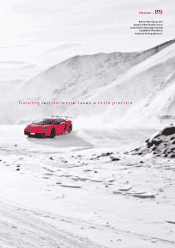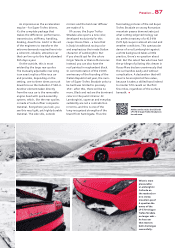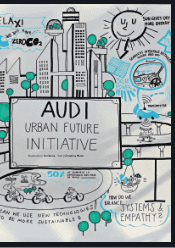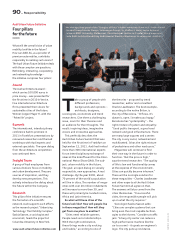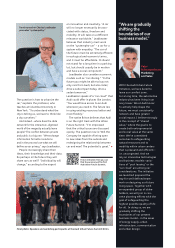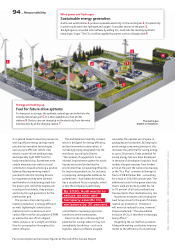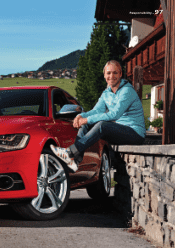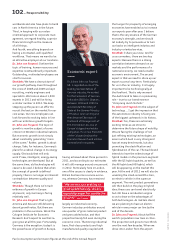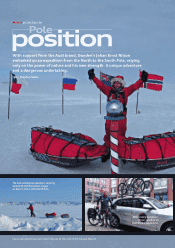Audi 2011 Annual Report Download - page 98
Download and view the complete annual report
Please find page 98 of the 2011 Audi annual report below. You can navigate through the pages in the report by either clicking on the pages listed below, or by using the keyword search tool below to find specific information within the annual report.
Sustained success is not only
defi ned by positive growth
in the key fi nancial fi gures –
it is also defi ned above all by
environmental responsibility.
We’ve been setting an example
in this area for a long time –
not because we have to, but
because we feel an obligation
to do so. We do not wait for
external pressure – the best
ideas at Audi come from inter-
nal sources. This is the pioneer-
ing spirit that has made our
company what it is today –
and it is what continues to
drive us. It is also behind our
commitment to the environ-
ment. One of my goals is to
neutralize CO₂ emissions
at our corporate sites. We
are achieving this by forging
new paths, researching new
technologies and continuously
thinking outside the box.
We need energy to produce
cars. But we can ensure that
we acquire this energy in
an environmentally compatible
way. We have already realized
numerous projects at the
Ingolstadt site alone. Effi cient
solutions such as using waste
heat, heat recovery systems
and trigeneration plants have
proved eff ective for many
years now. We are continuing
down this path with deter-
mination – with ideas that,
like Audi itself, might be
considered a bit “diff erent.”
“We have
to continuously
think outside
the box.”
Frank Dreves
Production
drive systems, Audi is also currently
fi eld-testing innovative drive systems
and fuels under realistic conditions in
three test series. These could help lower
emissions during driving. The prototype
Audi Q5 HFC draws its energy from a
fuel cell and tanks up on hydrogen. The
batteries for Audi A1 e-tron cars with an
electric drive system, which are currently
being driven in fl eet trials in Munich,
can be conveniently charged from the
electricity grid. And the Audi A3 TCNG,
which will begin rolling off the assembly
lines in late 2013, can fi ll up at any
natural gas fueling station.
Still, the Audi Group believes that it is
not enough merely to develop innovative
automotive drive systems to the point
where they are ready to use and then
introduce them to the market. As a
carmaker that thinks systematically,
Audi also has to keep an eye on having
an appropriate energy supply. This is why
Audi balanced mobility also includes
the e-gas project, in which excess wind
power is used to produce hydrogen and
synthetic methane. This should make
carbon-neutral mobility possible.
“At this moment we are realizing a
system that should make climate-neutral
driving possible for owners of Audi
models that run on electricity, hydrogen
or natural gas,” explained project man-
ager Reiner Mangold. The goal: cars that
drive with wind or solar power. Eff orts
to implement this concept are based on
familiar technologies. With the aid of
electricity, water is split into oxygen and
hydrogen in an electrolyzer. And by
adding carbon dioxide, hydrogen can be
converted into methane, which has the
same properties as natural gas. Thus,
it can be liquefi ed, transported through
pipelines, stored in caverns or tanks,
converted into electricity or used for
heating. It can also be used as a fuel
for cars. “So thanks to this technology,
there are three energy sources of the
future available simultaneously,”
Mangold emphasized: electricity, hydro-
gen and synthetic natural gas – known
at Audi as e-gas. Plus, there is another
special advantage: if you begin the
methanization process with electricity
produced from renewable resources and
add, for instance, CO₂ from a biogas
plant – which would otherwise reach
the atmosphere directly as emissions –
the synthetic methane produced in this
way is climate-neutral when used as a
fuel for cars.
Together with the company SolarFuel
GmbH, AUDI AG decided in May 2011
to establish the world’s fi rst industrial-
scale experimental plant. The plant,
being developed in the town of Werlte
in Lower Saxony, is planned to pro-
duce about 1,000 tons of e-gas annually
in the next few years – which will
enable 1,500 A3 TCNG cars to travel
15,000 kilometers each per year.
Another 150 tons of e-gas can also be
used in the public power grid for other
purposes, such as for the production
of electricity during low-wind periods.
The plant in Werlte is one link in a
comprehensive chain of energy pro-
duction: It will acquire the renewable
electricity from Audi wind turbines in
the North Sea off shore wind farm.
Electricity for operating the Audi e-tron
can then be obtained directly from the
power grid. The hydrogen that is pro-
duced through electrolysis is converted
into e-gas and fed into the existing
natural gas grid. Mangold sees an
“enormous inherent advantage” here
over hydrogen: “The natural gas distri-
bution network already exists. This
makes energy-consuming transport and
intensive investment unnecessary.”
Mangold highlights yet another major
strength of the e-gas project: “There’s
no need to place our hopes on tomorrow;
the infrastructure already exists.”
As soon as the plant in Werlte begins
operation, owners of an A3 TCNG will be
off ered the option to acquire e-gas.
The volume of natural gas they use to
tank up their cars will be compensated
for by feeding the corresponding
amount of e-gas into the grid. Its use as
a fuel will then be allocated through a
balancing group method. This will make
climate-neutral driving a reality.
The major strength
of the e-gas project:
the infrastructure
already exists.
Expedition on a 1:87 scale:
learn more about the Audi
e-gas project in miniature.


